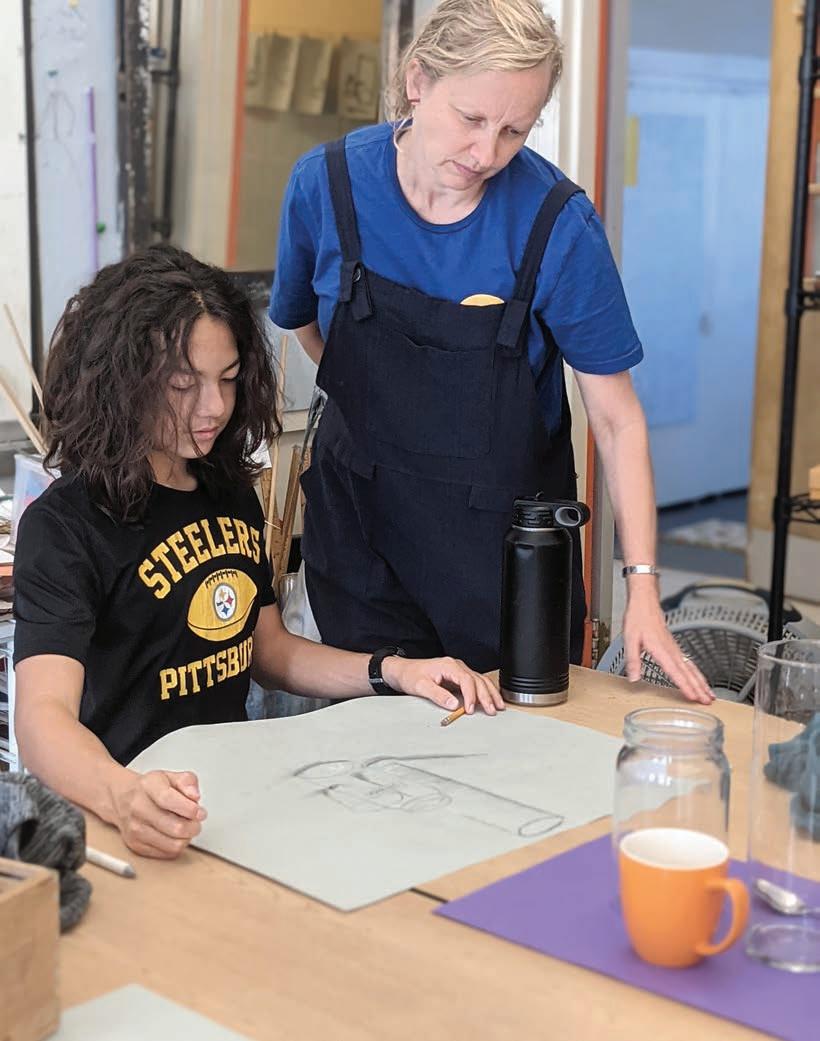
3 minute read
THE STEAMTEAM
CLARA BUCKLEY • CHLOE KO • KATE STREELMAN
This issue's column is written by Preschool and Middle School Art Teacher and STEAM Team member,Clara Buckley
Advertisement
I am an art teacher, and there’s so much more to me. As I planned for University in England, I wavered between engineering, architecture, and art. I picked architecture as the perfect combination of my love of the arts, math, and physics. After two years I missed hands-on art-making and switched my major to Contemporary Craft. I couldn’t see how my career would ever include my passion for science and math.
Then, back in 2012, I met with the fourth and fifth grade homeroom teachers and director, Kathy Hanson, to plan a new way of teaching Science and Social Studies at Mustard Seed School, STEAM. When the opportunity came to be involved in creating the STEAM program I jumped at the chance. Mrs. McCallihan and I completed training in innovative science and engineering curricula at Stevens University and were excited to implement this concept. I was definitely the only art teacher taking those classes!
We wanted to build on the exploration and creativity lower school students experienced in the Shared Space, while challenging them to develop their 21st Century skills of Critical Thinking, Creativity, Collaboration, and Communication. What better place for art to be involved! This Fall, the lower school art teacher asked the fourth grade students how STEAM was going. “We built on our knowledge of Hoboken row houses from the project we made before with you. But we have more independence now.”
Art has always been a component of STEAM and, as part of the teaching team, I guide the students' creativity. It’s an opportunity for me to continue my own learning. I’ve taught myself, and then students, many art skills including scientific drawing, creating scale plans, and topographic mapping. These were not the typical art classes I took in elementary school or college. These are visual languages that enable a child to more clearly record observations, create designs, collaborate with peers, and express their thinking to a wider audience.
When students move into grade 6, 7, and 8, they prepare for Science and Social Studies Exhibitions that require research, artifacts, and presentations. I delight in seeing the models our middle school students create. Their years in STEAM develop the students’ skills to a high level so they can independently produce beautiful and informative artifacts. I interviewed middle school students about their memories of STEAM and their recent solar system science models. Eighth grader, Baxter said that STEAM was the base for harder projects in middle school. He thought it covered the fundamentals for building and engineering. His classmate, Owen said that STEAM helped him learn how to build and get every piece “on point”. More recent graduates of our STEAM program, sixth grade students George and Victoria, remembered that despite COVID, STEAM helped them grow in independence and imagination. Victoria remembered the patience she needed when building her Rube Goldberg machine. George expresses STEAM gave him “power to believe in myself." As partners on a group project, Victoria and Cabot talked about collaborating in team based projects and working together to finish their model.
Whether our students pursue engineering, science, or art, in their future, the cross-curricula learning experience of STEAM helps develop well-rounded humans with a curiosity, creativity, and care for the world around them.
When I was in fourth grade, my great aunt Reina came to stay with us for two weeks while my mother visited Cuba to be with her parents and family whom she had not seen for many years. Reina was barely 5 feet tall. She was soft-spoken and always seemed to wear black dresses that matched her short wavy black hair. Reina, whose name means queen, did not speak English. My sister and I started referring to her as “Queeny,” believing she would not realize we were saying something about her in our “secret language,” English. We were wrong. She quickly figured out our code and told us so. We laughed and affectionately called her Queeny until she no longer honored us with her grace and kindness. Reina was the queen of belonging. She stayed in our two bedroom apartment in West New York, NJ for those two weeks. She slept in the living room in the “pimpam-pum (the guest folding bed), cooked, cleaned and loved us. Dad worked long hours and could not cook, so Queeny was our angel.
One day, I got home from school to find that she also performed magic! I had a pair of black MaryJane cloth slippers that I loved but could no longer use because I had ripped a hole in the big toe. They were not expensive but we could not afford a new pair. While I was at school, Reina found the slippers, and mended them with a needle and thread. How did she make them whole and new again? They were better than perfect; they were special now. It made a big impression on me that Reina






